需求
假设现在有一个H5需要有微信登录、手机号登录、邮箱登录 三种登录方式。让我们一起来看看微信登录如何实现吧
界面:
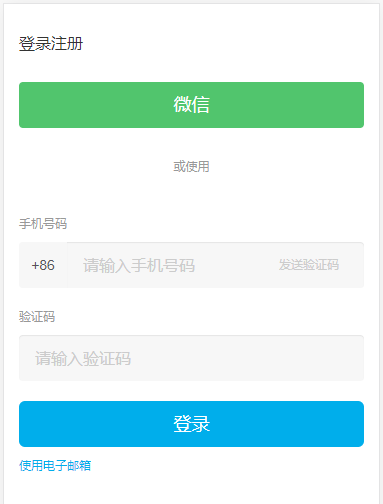
最终实现的效果图(登录成功后返回个人页):

因为微信登录目前没有实现移动端的其他浏览器授权登录,所以,再用除微信以外的浏览器操作登录时,我们需要给出用户提醒,比如这样:
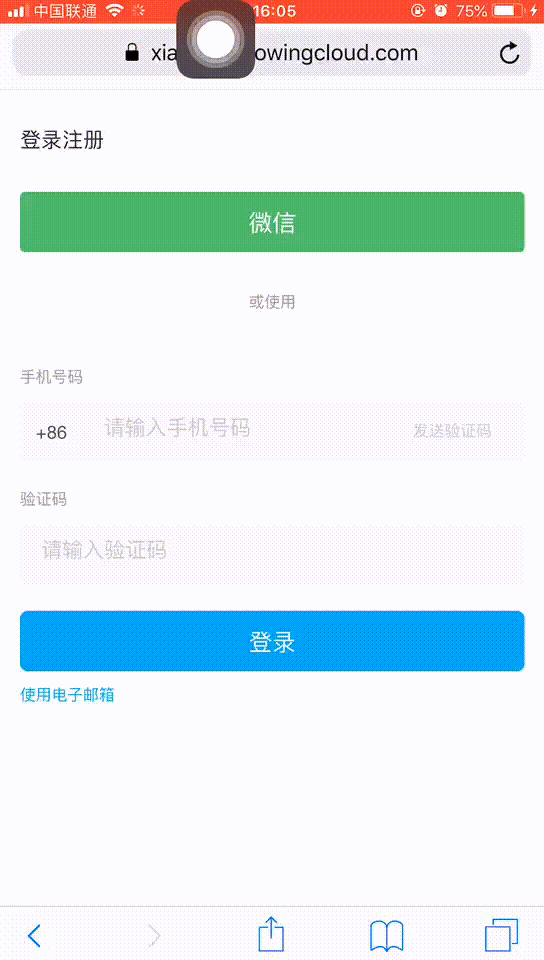
实现
准备工作
登录服务号或订阅号的微信公众号后台,找到AppId以及AppSecret。后面会用到

在公众号设置中,设置安全域名、js域名以及网页授权域名
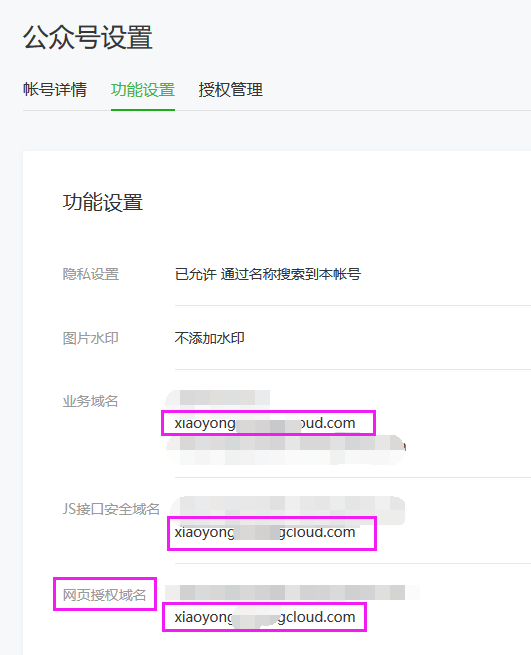
其中再网页授权域名设置的时候需要注意,将腾讯提供的一个唯一标识文件存放于项目根目录下

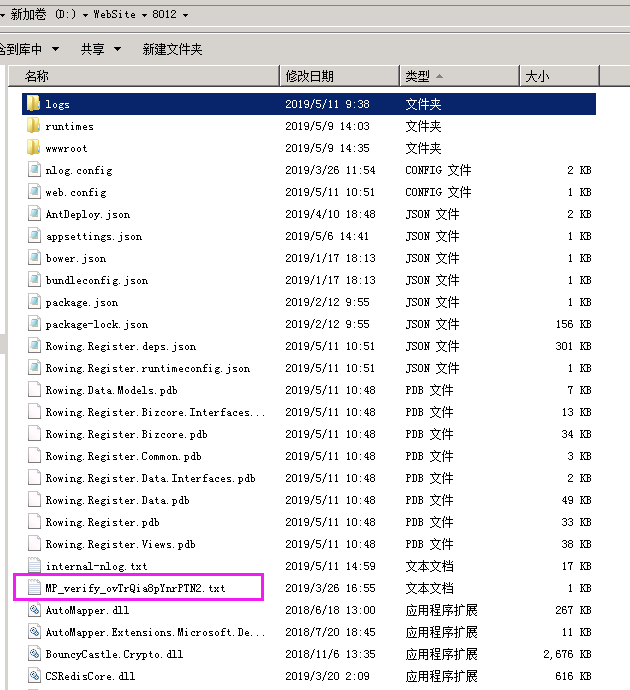 、
、
数据库部分
新建一张Login表,用于存放用户登录信息
CREATE TABLE `NewTable` ( `id` int(11) NOT NULL AUTO_INCREMENT , `loginaccount` varchar(100) CHARACTER SET utf8 COLLATE utf8_bin NOT NULL , `password` varchar(45) CHARACTER SET utf8 COLLATE utf8_bin NULL DEFAULT NULL , `type` tinyint(4) NOT NULL , `userid` int(11) NULL DEFAULT 0 , `isvalid` tinyint(2) NULL DEFAULT 1 , PRIMARY KEY (`id`) ) ENGINE=InnoDB DEFAULT CHARACTER SET=utf8 COLLATE=utf8_bin AUTO_INCREMENT=28 ROW_FORMAT=DYNAMIC ;

前端部分
前端要做的 比较简单,放置一个button按钮,以及js处理判断是否是微信内点击即可:
<div class="row"> <div class="col-xs-12"> <button type="button" class="btn btn-lg btn-block wechatBtn" id="weChatLogin">微信</button> </div> </div>
对应的js部分为:
$("#weChatLogin").on("click",
function () {
var layerLoading = layer.load(1, {
icon: 0,
shade: [0.3, 'black']
});
var result = isWeiXin();
if (result === 0) {
setTimeout(function () {
layer.closeAll();
var local = "回调地址";
window.location.href =
'https://open.weixin.qq.com/connect/oauth2/authorize?appid=服务号的appId&redirect_uri=' +
encodeURIComponent(local) +
'&response_type=code&scope=snsapi_base&state=a#wechat_redirect';
},
500);
} else {
setTimeout(function () {
layer.closeAll();
layer.msg("请在微信内打开~<br/>或尝试下其他登录方式哦");
},500);
}
});
上面这段js代码中,有两个黄色背景的代码需要注意,函数isWeiXin是用于判断当前用户打开的浏览器是否是微信浏览器,而参数snsapi_base则表示微信登录时采取的静默授权方式(即这样 只能获取到用户的Openid,无法获取到其他资料).
isWeiXin函数如下
//判断是否是微信浏览器的函数 function isWeiXin() { //window.navigator.userAgent属性包含了浏览器类型、版本、操作系统类型、浏览器引擎类型等信息,这个属性可以用来判断浏览器类型 if (browser.versions.mobile) {//判断是否是移动设备打开。browser代码在下面 var ua = navigator.userAgent.toLowerCase();//获取判断用的对象 if (ua.match(/MicroMessenger/i) == "micromessenger") { return 0; } else { return 1; } } else { //否则就是PC浏览器打开 return 2; } } var browser = { versions: function () { var u = navigator.userAgent, app = navigator.appVersion; return { //移动终端浏览器版本信息 trident: u.indexOf('Trident') > -1, //IE内核 presto: u.indexOf('Presto') > -1, //opera内核 webKit: u.indexOf('AppleWebKit') > -1, //苹果、谷歌内核 gecko: u.indexOf('Gecko') > -1 && u.indexOf('KHTML') == -1, //火狐内核 mobile: !!u.match(/AppleWebKit.*Mobile.*/), //是否为移动终端 ios: !!u.match(/\(i[^;]+;( U;)? CPU.+Mac OS X/), //ios终端 android: u.indexOf('Android') > -1 || u.indexOf('Linux') > -1, //android终端或uc浏览器 iPhone: u.indexOf('iPhone') > -1, //是否为iPhone或者QQHD浏览器 iPad: u.indexOf('iPad') > -1, //是否iPad webApp: u.indexOf('Safari') == -1 //是否web应该程序,没有头部与底部 }; }(), language: (navigator.browserLanguage || navigator.language).toLowerCase() }
后端部分
其中code和state是微信服务器发起请求的时候会带过来。code有效期为5分钟,state为自定义的一个参数,具体可参考微信网页授权文档:https://mp.weixin.qq.com/wiki?t=resource/res_main&id=mp1421140842
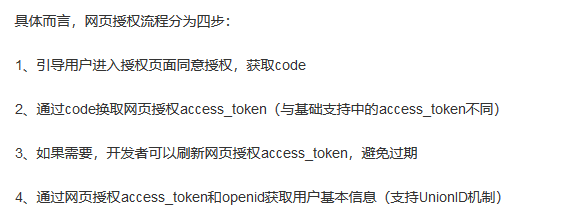
public async Task<IActionResult> Index() { var code = Request.Query["code"]; var state = Request.Query["state"]; OAuthToken tokenModel = new OAuthToken(); if (!string.IsNullOrEmpty(code) && !string.IsNullOrEmpty(state)) { tokenModel = await _dataServices.LoginWeChat(code, _config[ConfigurationKeys.PAY_APPID]);//调取接口
_logger.LogError($"微信登录:{tokenModel.Openid}");
code = string.Empty;
if (tokenModel.errmsg.Contains("success")) { var model = await _dataServices.GetUserByIdAccount(tokenModel.Openid);//具体可根据自己的项目业务来操作
//TODO
} } return View("~/Views/Home/Index.cshtml"); }
上述代码中从第一个OAuthToken说起,它是一个自定义存放微信授权的实体类,内容如下
public class OAuthToken:BaseRes { /// <summary> /// 网页授权接口调用凭证。注意:此access_token与基础支持的access_token不同 /// </summary> [JsonProperty("access_token")] public string AccessToken { get; set; } private int _expiresIn; /// <summary> /// access_token接口调用凭证超时时间,单位(秒) /// </summary> [JsonProperty("expires_in")] public int ExpiresIn { get { return _expiresIn; } set { ExpiresTime = DateTime.Now.AddSeconds(value); _expiresIn = value; } } /// <summary> /// 用于刷新access_token /// </summary> [JsonProperty("refresh_token")] public string RefreshToken { get; set; } /// <summary> /// 用户唯一标识。请注意,在未关注公众号时,用户访问公众号的网页,也会产生一个用户和公众号唯一的openid /// </summary> [JsonProperty("openid")] public string Openid { get; set; } /// <summary> /// 用户授权的作用域,使用逗号(,)分隔 /// </summary> [JsonProperty("scope")] public string Scope { get; set; } [JsonProperty("expires_time")] public DateTime ExpiresTime { get; set; } [JsonProperty("unionid")] public string Unionid { get; set; } }
其中BaseRes,是返回的错误实体类
public class BaseRes { public BaseRes() { errmsg = "success"; }
public int errcode { get; set; } public string errmsg { get; set; } }
第二个ConfigurationKeys.PAY_APPID是获取配置项
第三个LoginWeChat,我们来看看这个接口中是如何实现的
首先我们看到这个接口接收两个参数,和上面我们请求的参数与对应,一个是code,另一个是appId
[Route("[controller]/LoginByWeChat")] [HttpGet] public async Task<OAuthTokenDto> LoginByWeChat(string code, string appid = "") { return await _authenticationService.LoginByWeChat(code, appid); }
请求微信登录:
/// <summary> /// 通过code换取网页授权access_token /// </summary> /// <param name="appid">公众号的唯一标识</param> /// <param name="code">填写第一步获取的code参数</param> /// <returns></returns> public async Task<OAuthTokenModel> LoginByWeChat(string code, string appid = "") { var config = OpenApi.GetConfig(appid, PlatformType.Mp); var url = $"https://api.weixin.qq.com/sns/oauth2/access_token?appid={config.AppId}&secret={config.AppSecret}&code={code}&grant_type=authorization_code"; return await HttpUtil.GetResultAsync<OAuthTokenModel>(url); }
/// <summary> /// 根据appid,获取对应的接口参数信息 /// </summary> /// <param name="appid"></param> /// <returns></returns> public static ApiConfig GetConfig(string appid = "", PlatformType platform = PlatformType.Mp) { if (string.IsNullOrEmpty(appid) && apiConfigs?.Count > 0) { return apiConfigs.FirstOrDefault(a => a.Platform == platform); } return apiConfigs.FirstOrDefault(a => a.AppId == appid); }
public class ApiConfig { public string AppId { get; set; } public string AppSecret { get; set; } public PlatformType Platform { get; set; } = PlatformType.Mp; }
public enum PlatformType { /// <summary> /// 公众号 /// </summary> Mp, /// <summary> /// 小程序 /// </summary> Mini, /// <summary> /// 开放平台 /// </summary> Open, /// <summary> /// 企业号 /// </summary> Qy }
/// <summary> /// 发起GET请求,并获取请求返回值 /// </summary> /// <typeparam name="T">返回值类型</typeparam> /// <param name="url">接口地址</param> public static async Task<T> GetResultAsync<T>(string url) { var retdata = await HttpGetAsync(url); return JsonConvert.DeserializeObject<T>(retdata); }
这里我们调用了Get异步请求:
public static async Task<string> HttpGetAsync(string url) { var request = CreateRequest(url, HttpMethod.GET); return await GetResponseStringAsync(request); }
private static HttpWebRequest CreateRequest(string url, HttpMethod method, string postData = "", string certpath = "", string certpwd = "") { var request = (HttpWebRequest)WebRequest.Create(url); request.Method = method.ToString(); request.ContentType = "application/x-www-form-urlencoded"; request.Accept = "*/*"; request.Timeout = 15000; request.AllowAutoRedirect = false; ServicePointManager.ServerCertificateValidationCallback = new RemoteCertificateValidationCallback((a, b, c, d) => true); if (!string.IsNullOrEmpty(certpath) && !string.IsNullOrEmpty(certpwd)) { X509Certificate2 cer = new X509Certificate2(certpath, certpwd, X509KeyStorageFlags.PersistKeySet | X509KeyStorageFlags.MachineKeySet); request.ClientCertificates.Add(cer); } if (method == HttpMethod.POST) { using (var sw = new StreamWriter(request.GetRequestStream())) { sw.Write(postData); } } return request; }
private static async Task<string> GetResponseStringAsync(HttpWebRequest request) { using (var response = await request.GetResponseAsync() as HttpWebResponse) { using (StreamReader reader = new StreamReader(response.GetResponseStream(), Encoding.UTF8)) { return reader.ReadToEnd();//获取响应 } } }
public enum HttpMethod { GET, POST }
这样,我们就可以拿到返回的响应结果了
OAuthToken resultDto = JsonConvert.DeserializeObject<OAuthToken>(resultDetail); _logger.LogError($"OpenId:{resultDto.Openid},ErrorMsg:{resultDto.errmsg}"); return Task.FromResult(resultDto);
我们查看日志,可以看到OpenId已经被打印出来了

这样,我们只需要将我们的Openid 再数据库中进行查找,就可以知道是否存在此用户,若不存在,则可以操作新增
//判断是否数据库有登录记录 ,若无则新增 if (!string.IsNullOrEmpty(model.Openid)) { var result = await _authenticationDataServices.FindAccountById(model.Openid); if (string.IsNullOrEmpty(result.LoginAccount)) { LoginUserModel userData = new LoginUserModel { LoginAccount = model.Openid, Password = string.Empty, Type = (int) LoginType.Wexin, UserId = 0, IsValid = true }; var res =await _authenticationDataServices.AddLoginUser(userData); if (res <= 0) logger.Error(res); } }
查找用户的实现
public async Task<LoginUserModel> FindAccountById(string account) { using (var conn = GetMySqlConnection()) { if (conn.State == ConnectionState.Closed) { await conn.OpenAsync(); } try { string sql = @"select Loginaccount,Password,Type,Userid,Isvalid from centraldb.login where loginaccount=@recordId;"; var user = conn.Query<LoginUserModel>(sql, new { recordId = account }, commandType: CommandType.Text).FirstOrDefault(); return user ?? new LoginUserModel(); } catch (Exception e) { throw; } } }
新增的实现
public async Task<int> AddLoginUser(LoginUserModel loginUser) { using (var conn = GetMySqlConnection()) { if (conn.State == ConnectionState.Closed) { await conn.OpenAsync(); } const string sql = @"insert into centraldb.login(loginaccount, `password`, `type`, userid, isvalid) values(@loginaccount, @password, @type, @userid, @isvalid); select max(id) from centraldb.login;"; try { var userId = (await conn.QueryAsync<int>(sql, new { loginaccount = loginUser.LoginAccount, password = loginUser.Password, type = loginUser.Type, userid = loginUser.UserId, isvalid = loginUser.IsValid }, commandType: CommandType.Text)).FirstOrDefault(); return userId; } catch (Exception e) { return -1; } } }
这样,运行项目之后,数据库中就会插入相应的数据:
